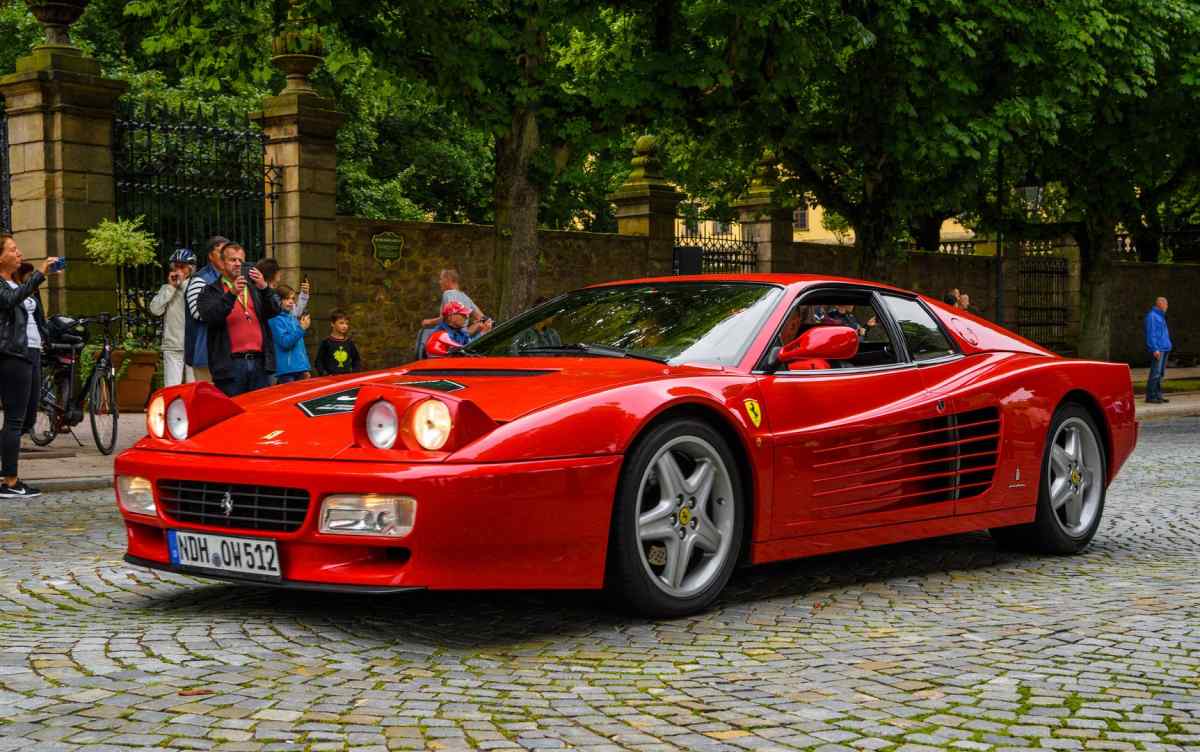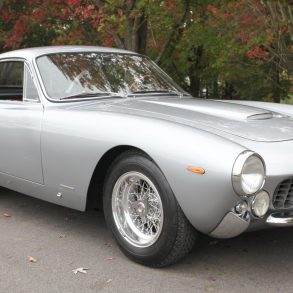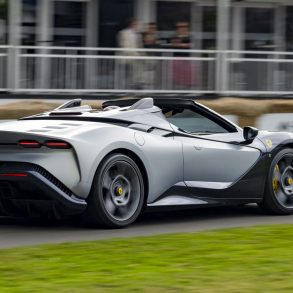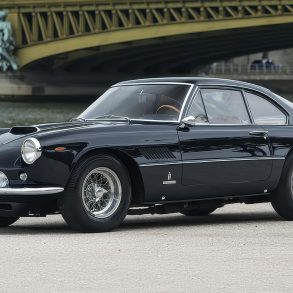Starting from its first car in 1947 to this very day, Ferrari has created a near-endless array of genuinely legendary automobiles, more than a few per decade for sure. Still, there is rarely any Ferrari more iconic than the Ferrari Testarossa.
With its growling flat-12, theatrical design and the name that just screamed passion, the Testarossa perfectly epitomized the neon-clad excess of the 1980s. The overdramatic side profile made it an ideal car for the outrageous era that focused on showing off whenever possible.
Unsurprisingly, the car didn’t only look godlike, but it was also a fantastic driver’s car. Today, we’ll get behind the magic of the Testarossa and see what makes it an integral part of childhood dreams and collectors’ aspirations.
Background
The spark that ultimately led to the Testarossa could be traced to the infamous 1968 Geneva Motor Show and the appearance of the naked Miura.

Lamborghini’s placement of a V12 in the back infuriated Enzo Ferrari but prompted the company to rethink its road car philosophy dominated by front-engined V12-powered grand tourers.
For long, Mr. Ferrari considered the mid-engined concept too raw for his traditional clientele, but the Miura forced him to start thinking in that direction. After years of negotiations within the company walls, Enzo finally greenlighted the development of a mid-engined car.

When presented, the 365 GT/4 BB was an advanced concept, utilizing the engine derived from Formula One, a longitudinally mid-mounted flat-12. The overhauled line-up was soon joined by the Mondial, the 308, and the revived Dino range, featuring another first for Ferrari: Bertone’s design.
A new line of Maranello’s thoroughbreds performed well on the exotic market, but as Ferrari was still producing its flagships in modest numbers, the 365 GT/4 Berlinetta Bialbero saw just 387 sold in a three-year production run after which Ferrari decided to radically beef up the successor.

Departing from his way of naming 12-cylinder cars after the displacement of a single cylinder, Enzo revived a name echoing what Ferrari did the best, that being prototype racing. The successor was named 512 BB, referring to a 5-liter 12-cylinder residing behind the cabin. The 512 range was thus born, spawning from 1976 to 1984. Midway into production in 1981, the 512 BB was upgraded to a fuel-injected variant 512 BBi in 1981.
The concept of a flat-12 utilized by the 512 range still had space for improvements in all departments so the development of the successor already began in 1978.
Development of the Ferrari Testarossa
Four main people were critical for the development of the vehicle. The Project Department was led by Angelo Bellei with Nicola Materazzi responsible for reengineering the flat-12, while the head of Ferrari’s Experimental Department, Maurizio Rossi, took care of the rest of the car. Styling was head by the legendary Leonardo Fioravanti at Pininfarina.

The first and the most important goal for the 512BB’s successor was to make it compliant with US safety and emission standards. During very difficult times for the supercar segment, the 512 couldn’t be imported to the United States, so naturally the first goal was to make it ready for export to the most lucrative market.
Next, the engineering team had to fix a notorious engineering oversight of the 512 BB, the cabin heat caused by hosing from the front-mounted radiator.
Regulating this meant that the new car would be more civilized, thus comfortable and more convenient for regular driving. For more power, Materazzi completely revised the engine and its paraphernalia, thus completing the mechanical overhaul of the new flagship car.
Once the vital parameters were set, Ferrari gave the briefing to Pininfarina and its chief designer Leonardo Fioravanti. Pininfarina’s design team of Ian Cameron, Diego Otina, Emmanuele Nicosia, and Guido Campoli soon started brainstorming a new shape, more attractive and more radical than before, but still more usable than the 512 BB. Three years later, Emanuele Nicosia penned the final design of the car and the development process was nearing its final stages.

The Ferrari Testarossa was introduced at a grand event at the Lido de Paris cabaret in October 1984, while the public outing was at the Paris Auto Show where two vehicles were displayed, one gracing Ferrari’s stand and another at Pininfarina’s.
The name Testarossa summoned the spirits from Ferrari’s glorious racing history and red valvetrain covers on the iconic 250 Testa Rossa racing car. A verbal name resonated better on the American market and Testarossa was just the right one, both passionate, exotic, and highly descriptive.

Until the end of its production run, the car was gradually improved but was thoroughly revised twice.
The first major visual and functional upgrade came in 1991 with the 512TR, whereas the second one was 1994 to 1996 512M, or Modificata, the rarest variant of the car produced in 501 copies.
The chassis and the bodies were built by an outside contractor, Turin-based ITCA and then sent to Pininfarina for paintwork and trim. The final assembly was completed at Maranello.

Chassis
Like many supercars of the day, the vehicle was built on tubular steel chassis. Compared to the 512 BB and BBi, the floorpan was both longer and wider with an increased wheelbase, giving the car better, more balanced handling.
The main difference in the chassis, however, was that the vehicle had a removable engine bolted onto the main chassis which could be unbolted to provide easier maintenance of the engine and the suspension.

The 512TR that came out in 1992 brought significant changes engineered to make the driving even sharper and more precise.
The one-piece chassis replaced the bolt-on engine compartment, enabling greater torsional stiffness and even lower placement of the engine and the gearbox.
The changes resulted in greater responsiveness and more confident control in the corners. The 512M didn’t go through chassis revisions, but increased power output and revised suspension further distilled the Testarossa experience.
The weight balance of the vehicle was rear biased at 40:60, but further revisions balanced it better. That being said, the 512TR had 41:59 and the 512M was 42:58.

Body of the Testarossa
The shape of the car was a radical departure from the sharp wedge-shaped contours of its predecessor. The front end was rounder than on the 512 BB and the rear of the car was considerably wider due to the shuffled internals, most notably the rear-mounted radiators. Finally, the final look replaced the recognizable round rear with an attractive blacked out louvered rear end hiding the rectangular light formation.


Many styling elements on the vehicle were motivated by function and the most prominent part of its unforgettable character was there as a compromise. Yes, the famous grates gracing the doors had to be installed due to certain European countries having regulations forbidding large open holes in the bodywork.

The intakes feeding air to the side-mounted radiators couldn’t be made any smaller, so Ferrari used a set of strakes to mask them. This proved to be a defining character line for the Testarossa and a subsequent inspiration for numerous tuners who copied this style on outrageous 1980s body kits.
Another trademark detail, although seen only on the early vehicles, was the ‘Monospecchio’, the infamous single door mirror positioned unusually high on the door frame.
This asymmetric trait was a result of a free interpretation of European regulations regarding rear visibility and was a subject of many complaints both on the native continent and in the US.

Starting from 1986, the car got conventionally positioned double mirrors, first in Europe and then in the United States for the 1987 model year.
In the second iteration dubbed 512TR, Pietro Camardella revised the original design, with a more modernized front end featuring a softer body-colored front bumper with larger one-piece auxiliary lights, followed by an updated engine cover design and revised rear lights too.

Finally, the ultimate iteration of the Testarossa, the 512M, ditched the iconic pop-up headlights in favor of glass-covered beams. Alongside new headlights, the whole front end was thoroughly revised with a new modern front bumper and a curvaceous hood adorned with two NACA ducts. Ultimately, the rear end saw the return of round taillights, preparing the public for a successor, the more conventional 550 Maranello.

Ferrari never envisioned the car as a convertible, however, there is a sole official soft top Testarossa and it is Gianni Agnelli’s convertible. The 62897 vehicle finished in Argento Nürburgring was commissioned by Agnelli to celebrate his 20th anniversary as Fiat chairman.

Increased interest in the convertible car led tuning companies to make their own renditions of the topless supercar. The most famous of them all actually didn’t exist in real life. It was the pixelated red Testarossa drop top from the SEGA OutRun arcade game!

Engine and Transmission
Making the powerhouse worthy of a new flagship car, Nicola Materazzi significantly improved the flat-12 engine from the 512BB.

The longitudinally-mounted 4.9-liter engine shared the same displacement, bore, and stroke as the unit from the predecessor, but it had more than a few revisions, the most notable being four valves per cylinder and four camshafts running off the crankshaft, an improvement over the previous construction where they were driven via idler gears.
Initially, the F113A vehicle had 385 horsepower with 361 lb-ft of torque in Europe and 380 horsepower with 346 lb-ft in the US. These numbers were good for a 5.3 second 0-60 run with a top speed of 177 MPH. The flat-12 was coupled with five-speed manual transmission.
Starting from 1989, the 113B was a revised version of the engine featuring the more modern KE-Jetronic instead of the K-Jetronic found on the F113A.

The upgraded 512TR brought an revised powerhouse named F113D featuring a different air intake, larger intake valves, Nikasil-coated cylinder liners, and a revamped exhaust.
Paired with Bosch Motronic 2.7 engine management, the 512TR’s output was pumped to 421 horsepower, and the revised ratio five-speed with a new single-plate clutch gave it a faster 0-60 time of 4.8 seconds and an increase in top speed to 195 MPH.
Finally, the 512M’s F113G was good for 440 horsepower and 370 lb-ft thanks to higher compression ratio, titanium conrods and lighter crankshaft. The engine was now able to howl up to 7500 RPM and the driving sensation was thus increased, just like the performance: 0-60 of 4.7 seconds and a top speed of 196 MPH.
Steering and Suspension
The car was equipped with rack-and-pinion steering, and the steering ratio had been made quicker throughout the revisions to give the car more precision with each new variant of the car.
The vehicle had independent front suspension with unequal-length wishbones, coil springs, telescopic shock absorbers, anti-roll bar Rear suspension coil springs, telescopic shocks and anti-roll bars.
The front suspension had single shocks, whereas the back had twin shocks at each wheel. Throughout the production span, this basic layout was retained, but was further finessed for better road holding.
Brakes, Wheels and Tires
The first cars had a single-bolt wheel, but in 1988, the single-bolt design was dropped in favor of conventional five-bolt five-spoke wheels made by OZ and Speedline. These changes resulted in revised suspension, steering column, shocks, brakes, and ultimately a wider track. This sub-variant of the Testarossa built from 1988 onwards is referred to as 88.5.

Single-bolt front wheel dimensions were 210 TR 415 in the front and 240 TR 415 at the rear with low profile Michelin TRX tires in 240/45 VR 415 and 280/45 VR 415 respectively.
Starting from 1986, the single-bolt wheels adopted conventional wheel sizes of 16x8J front and 16x10J, the same dimensions as the later five-bolt design. The tires were 225/50 VR 16 front and 255/50 VR 16 rear.
The 512TR and the 512M had larger 18-inch wheels, 18x8J front and 18×10.5J rear and were fitted with modern rubber, 235/40 ZR 18 and 295/35 ZR 18 respectively. The final 512M variant was factory fitted with Pirelli P-Zero.
The original Testarossa had four-wheel disc brakes measuring 315 mm in the front and 310 mm at the rear with no anti-lock brakes and the dimensions didn’t change throughout the production span. However, the 512M benefitted from cross-drilled brake discs, enabling even more efficient stopping power when paired with new modern low profile tires.
Interior
Yes, the car was definitely more spectacular from the outside, but being behind the wheel had its own perks too.
The interior of the vehicle was a harmony of clean geometric shapes and classic Ferrari elements such as simple Momo Prototipo wheel and superbly smooth Connolly Autolux leather. The Testarossa could be ordered in six complementary shades of leather and carpeting, from the classic black and beige to the extravagant all-red leather interior.

For 1980s supercar standards, the interior of the car was roomy and comfortable which was another goal achieved by Pininfarina. With that in mind, the vehicle felt more like a grand tourer than a race car derivative and that was one of its biggest upsides over its biggest competitor – the cramped and agonizingly impractical Countach.

The updated 512TR had a modernized interior with circular aircon vents relocated to the center of the dashboard, a beefier steering wheel, redesigned center console and softer lines overall.
The cockpit of the 512M was a continuation of the 512TR revamp with a more ergonomic steering wheel, drilled aluminum pedals, air-con as standard and subtle changes making the final Testarossa feel on par with its contemporaries.
Testarossa: Pop Culture Icon
After the grim 1970s marked by the fuel crisis, the 1980s brought a wave of joy and optimism which naturally reflected on pop culture. At its zenith, the eighties were the most decadent and the most flamboyant era of modern humanity and two cars summed it up perfectly. One was the overdramatic Countach and the other was the Testarossa.

Throughout the eighties, these two cars battled for the ultimate expression of opulence and debauchery and frankly, both were the poster cars everyone woke up to in their teenage bedrooms.

The decade-defining Miami Vice saw Don Johnson’s character Sonny Crockett cruise around in a white Testarossa gifted to the production team by Enzo Ferrari himself. That way, the Testarossa was immortalized in TV history and the it-car in the 1980s mythology.
While the kids were drifting around in a red Testarossa convertible in the arcades only to bike home and watch Crockett & Tubbs, the who’s who of the 1980s and the early 1990s were very publicly displaying their wealth and success by showing up in a Testarossa.

The star-studded Testarossa ownership club included Iron Mike Tyson, Miles Davis, Elton John, Rod Stewart, two of the greatest MJs of all time, Michael Jordan and Michael Jackson, as well as one not so great, OJ. And just like in the movie, the real Wolf of Wall Street, Jordan Belfort, drove a white Testarossa too.

Legacy
Nearing forty, the Testarossa aged beautifully and it is still as relevant as it ever was. A timeless pop culture icon, the car is seen everywhere, from GTA games where it’s called the Cheetah, to Kavinsky’s videos and glamorous photo shoots. Its unforgettable lines evoke both nostalgia and timeless passion
Needless to say, the iconic status and thrilling driving abilities mean that the prices for the Ferrari are on a constant rise, the priciest being the one-of-501 512M. The hardcore Testarossa enthusiasts will probably go with the original design and one of 7,177 produced examples, but the 512TR offers a more refined driving quality, albeit at a higher price, in part due to a more restricted production run of 2,261.
Being the last mid-mounted flat-12, the car didn’t produce a direct heir and as such it holds a very special place in Ferrari’s history. All this makes the Ferrari Testarossa an emblematic car that will be fondly remembered in decades to come.











Please do remember that the first time the name Testa Rossa was used it was for a 1956 four cylinder 2 liter race car, the MDTR.
A very interestering, detailed and elaborated article, but Olivier Gendebien: “One of the greatest sportscar racers
of all time; was owner like Gianni Agneli of a Testarossa Spider. His car was black.